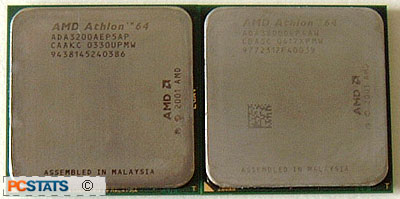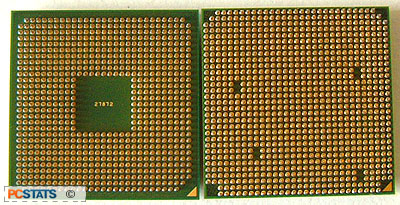AMD Technology: Cool 'n' Quiet
When
AMD released its long awaited Socket 939 version
of the Athlon64 in June of 2004, it was almost nine months after the original
Socket 754 Athlon64's came into being. Unfortunately for end users, many of
the original Socket 754 motherboards did not support all the Athlon64
native technologies, like Cool 'n' Quiet.
It's a
shame because C'n'Q (as AMD
calls it) actually works quite well at reducing the heat and noise, as well as
the amount of electricity the CPU draws. What C'n'Q does is dynamically lower the speed at
which the processor runs, depending on the applications currently running on the
PC, and how much CPU load is being applied.
 |
| The
AMD Athlon64 socket 754 processor is on the left, the Athlon64 socket 939 version to the right. The differences between each type of processor all boils down to support for dual channel DDR memory. |
 |
Cool 'n' Quiet is actually not
a new feature as it's built into Socket 754 Athlon64's as well. Unfortunately
most motherboard manufacturers just didn't enable it. This time around, for
manufacturers to make AMD's Socket 939
recommended
list , Cool 'n' Quiet must be enabled and
supported by default!
With C'n'Q enabled,
the motherboard will automatically lower the clock multiplier based on the
level of CPU load and use. Obviously at a lower overall speed the processor will
not run as hot and it will not draw as much power either, meaning that an Athlon64
based system with C'n'Q is also more economical in the long run.
In
conjunction with
the lower CPU speed, the CPU fan rotation also decreases,
which helps to reduce the overall noise level coming from the PC. When the system detects more load,
it will automatically scale the CPU and fan speed higher to meet the
demands.
Enhanced Virus Protection
AMD has taken
it upon itself to try and protect its users from possible virus/worm attacks
that can exploit memory buffer overflow errors. This is accomplished
with AMD's new Enhanced Virus
Protection technology. EVP is a new technology, currently unique to
AMD's 64-bit Socket 939 CPUs, that is designed to halt certain virus and exploit
attacks as they occur. EVP works hand-in-hand with Microsoft's DEP (Data
Execution Prevention) code introduced in Service Pack 2 for Windows XP.
When it is enabled (by
using a compatible processor like the Athlon 64 3800+) the operating system
watches for certain anomalies that often signify a virus or exploit attack, like
code being executed in memory spaces where program code does not belong. In this
way, buffer overflow attacks which overload a legitimate memory space allowing
foreign code to be run in unprotected memory location, will be stopped short as
soon as they occur.
Past, present and future...
After AMD
released the Athlon 64 in September of 2003, the company seems to have taken over the driver's
seat from Intel in terms of cutting edge CPU technology. While the Intel Pentium 4
features technologies like HyperThreading and SSE3, they're more like evolutionary steps. Having a processor
that can run both 32 and 64 bit computing is revolutionary, and Intel is
starting to feel the
heat.
In fact
Intel, which had scheduled desktop 64 bit processors a few years
down the road was forced to scrap its plans and include AMD style 64-bit compatibility
in recent desktop parts - called "EM64T." Now all that's left to complete the
change over to 64-bit desktop computing is Windows XP 64-bit Edition, slated
for release in April 2005. Linux has already "been there, done that," but few
have noticed.
|
